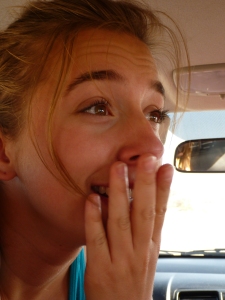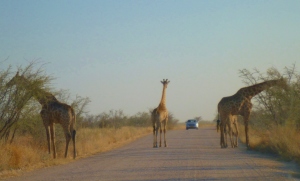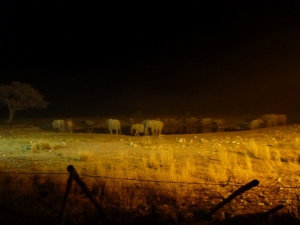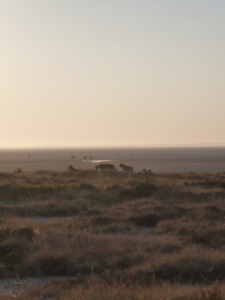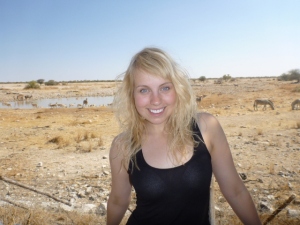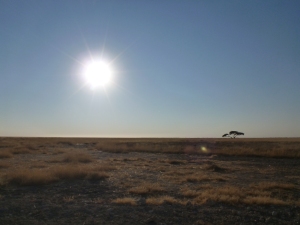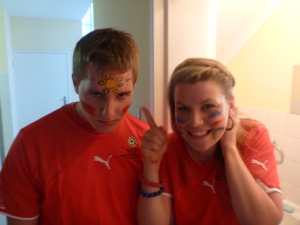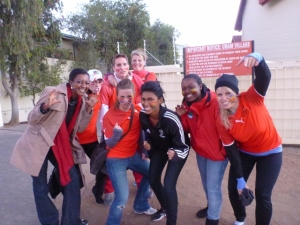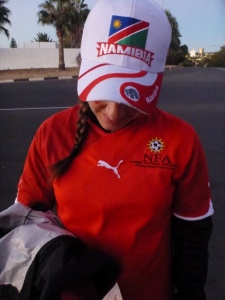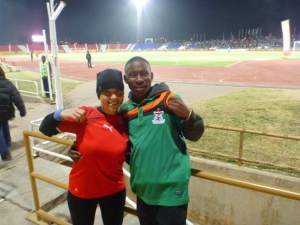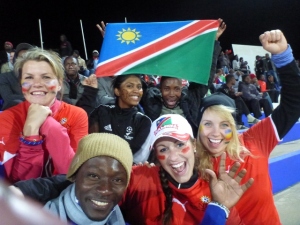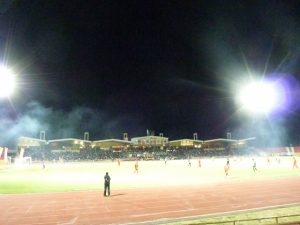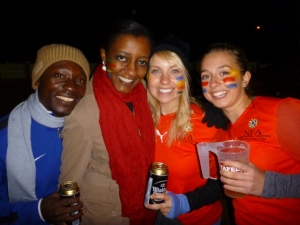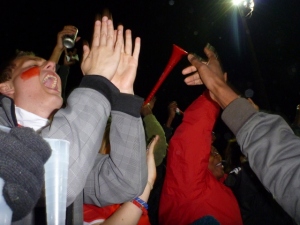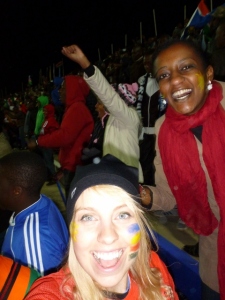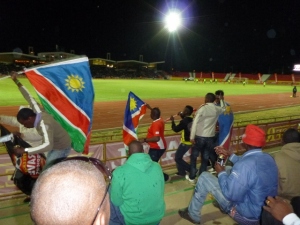Monthly Archives: July 2012
Unexpected International Experience
One thing that I love about traveling is seeing how my new environment acts and interacts with other countries and cultures.
While I know Erin disagrees with me, I have found an unexpected collision of cultures, and I LOVE it!
China Town in Namibia.
This place is AWESOME! I feel some of my grandfather’s thrifting has worn off on me when I admit this, but China Town is a treasure trove of steals and deals! One thing that Erin and I agree on is that said steals and deals become repetitive since the same products (or slight variations thereof) are sold in every shop, but the overall experience and occasional find are exciting!
Think about what you would expect China Town in Windhoek, Namibia to look like.
Now forget that entirely.
It actually looks like it used to be a storage complex, but each storage unit has been turned into a shop stall.
There’s a mix of trinkets and nick-knack shops, but there are a few stores that look like they would fit right in at Wernhill or Maerua Mall (the two malls in Windhoek)! At one such store, Simmie’s Fashions, I bought a purse. I always brag about how I found it in China Town… usually – but not always – without prompt.
I know that my Dad is probably saying something out loud about my student budget as he reads this, but don’t worry Dad! I don’t have time to go shopping in China Town when I have project deadlines, hair to have braided, nails to get done… Things are just way too busy. Suffering students is right, eh! haha We’ll keep you as posted as possible in the next two weeks!
Look forward to the braiding before and after pictures Erin and I will be posting after we get our hair done tomorrow!!
-Amber
Rusks!
Rusks (also known as beskuit in Afrikaans) are a common South African (and Namibian) breakfast food and treat enjoyed dipped in coffee or rooibos (meaning red bush, the plant from which the tea is made, in Afrikaans) tea. One can buy all sorts of varieties in the grocery stores, ranging from plain buttermilk rusks to chocolate rusks to muesli rusks. Rusks are twice-baked cookies not unlike Italian biscotti. To make them, a rusks pan is desired, although I plan on making some at home with a few improvisations. A rusks pan is a shallow pan (about 1inch deep) and comes along with a cutting frame to score the rusks before the first bake. Instead of such a device, I’m pretty sure we could just use a knife for a similar effect – it would just take a bit longer.
Here is the recipe for the rusks I made one Saturday morning at my friend Attie’s house, following a long run. The recipe comes from his friend, Ramsy.
Ramsy’s Rusks
INGREDIENTS:
1.5 kg self-rising flour
3 tsp baking powder
1 tsp salt
300g crushed bran cereal
3 large eggs
500g margarine
½ cup oil
500 mL buttermilk
2 cups sugar
Several handfuls each of raisins/coconut/seeds/nuts/whatever you wish
DIRECTIONS:
Mix flour, baking powder, salt, crushed cereal, nuts/dried fruit/seeds. In a separate bowl, beat eggs and then add margarine, oil, and buttermilk. Beat well. Add sugar and beat well. Mix wet and dry ingredients. If dough is too hard, add more buttermilk to soften it. Mix dough with hands. Spread dough evenly onto a rusk pan, press in the rusk cutting frame to score the dough, and then put it in the oven. Bake at around 155°F for 1hr. Take pan out of oven and let cool for 30min. Cut scored rusks with a knife and place rusk pieces upside down on pan, keeping rusks separated from each other. Dry rusks in oven at around 100°F for 4-5hrs, keeping the oven door open slightly. Store away from moisture. Enjoy!
-Erin
Traditional Owambo Meal
Mateu, a Namibian friend introduced to us by one of our co-workers, so graciously invited all of us Canadians over to his aunt’s house for a traditional Owambo meal with their family. So, one Saturday evening we were picked up by Mateu and his brothers, Robert and Shafa, and driven to the dinner. We were greeted warmly by Helena (their aunt), some women of the family (Happy and Queen), Junior (Mateu’s little brother), and baby Tuli. Helena was dressed in her traditional Owambo dress. She looked beautiful!
We were served some mahango pap, a traditional spinach dish, chicken, goat, a traditional sausage, wine, champagne, and…. fried MOPANE WORMS! I unfortunately lost most of the photos I took from this evening, but please, Google image mopane worms. Everyone politely helped themselves but I was last in line for food and at that point, Mateu had started serving. Lucky for me, mopane worms are one of Mateu’s favourite dishes and he therefore figured I’d really like them too! With that in mind, he put not one on my plate, but a nice heaping scoopful! On the count of three, I started eating them. I was surprised at how chewy they were: each worm required I would say…. 12-15 chews. However, I was really relieved that you couldn’t feel any legs or what have you in your mouth. Amber managed to get half of one down. It was a struggle. The other girls managed on theirs as well. I pawned off as many as was polite to Mateu’s family members who really like them, but was still left with about 10 worms x 12-15 chews. So, I ate them. I had this silent chant going on in my head: “high in protein, high in protein, high in protein, high in protein…” and that’s what I attribute my being able to clean my plate. Being the pickiest meat eater in the house, it was a surprise to us all (myself included!) that I was able to put them in my mouth, let alone finish. I guarantee that my family (especially Mom and Emily) and my friend Rosa (together we took part in the Mitsubishi City Chase last summer in Toronto and I failed miserably at a spider-touching and worm-eating challenge) will be equally surprised!
Above: Shafa serving the meal with Queen laughing in the background.
Below: Us about to tuck into the meal. Note the pile of mopane worms on my plate! (The dark brown section of the plate).
Following dinner, the music was turned on and a dance party began! Where Amber lacked on the mopane worm eating at dinner, she more than made up for on the dance floor by DOING the worm! Atta girl, Amber! We were taught some Namibian-style dancing and had a great time laughing and dancing and following along.
Thank you so much to Helena and family for welcoming us into your home and treating us to a lovely Namibian evening!
Here is a picture of Helena with Robert (in the red), Shafa, and little Tuli:
-Erin
Lizz
What Lizz lacks in height, she makes up in personality! She’s a dedicated rock climber and I can’t imagine her backing down from a debate any more than I can imagine her backing down from a rock face. She’s both critical and sensitive, and has a bubbly and infectious laugh. The most interesting (and ironic) thing I’ve learned about Lizz is that her favorite animal is the giraffe! Here’s a photo of her seeing a giraffe for the first time and one of the reflections that she let us share on our blog.
On the outskirts of AIDS
One of the reasons I applied, and adamantly wanted, to come on this exchange was to get a chance to learn more about HIV and AIDS in a real-world context. I wanted to see how it affects communities, and to have a chance to be part of the response to this global pandemic. I really wanted to have a chance to research, learn about, and gain a more informed understanding of the complications and consequences of HIV in Africa. PAY has been both eye-opening, and disappointing in some respects in fulfilling this desire.
The reality is that HIV is not always a visible part of everyone’s life here. Sometimes it hides there right under the surface. It heavily affects the community, and you can sense it’s presence on the outskirts of conversations. Death, for example, has become something that the kids and volunteers at PAY have become accustomed too. I want to clarify that, by making sure that this conditioning isn’t mistaken for any amount of callousness. It’s instead, the consequence of the seemingly continuous occurrence of funerals in their lives. Many of the kids we work with attend what seems to an enormous amount of funerals on weekends. Even some of the people we live with have attended funerals through their placements at the beckoning of their coworkers who’ve asked them to come for moral support.
It’s just something I’ve found to be so contradictory when comparing our placement at PAY with the other placement groups in Namibia. Jordan and I are the only two here who are not dealing with the direct realities of the disease on a daily basis. Two of the other girls here work for the Women’s Health Network and come home discussing the current work surrounding the issues of the sterilization of women with HIV and the stigma towards sex workers and migrants. The other two work in a pharmacy in an HIV clinic and spend their entire days counselling HIV and AIDS patients and handing out prescriptions for ARVs. The presence of HIV and AIDs is immediate and undeniable, whereas at PAY the presence is much more indirect
At PAY the topic has never come up in any typical daily conversations. The only evidence that it’s ever been brought up is that of a banner that hangs above the staff room, that’s been coloured in with crayons and coloured pencils that says ‘ending stigma of AIDS’, and has pictures of condoms and the words ‘abstain’ and ‘safe sex’ circled in thought bubbles.
On the other hand, the absence of HIV from my work has also taught me a lot about the issue. Predominately two things: one of the ability for a community to survive, and even for sections of it to thrive, despite the underlying epidemic. The second is for the importance of literacy and education to combat poverty and the health problems that unfortunately go hand and hand with it. HIV is a problem Namibia suffers from, but it does not define the conversations and daily lives of all of its inhabitants. Some of the kids may be HIV positive. They are however, still participating in sports, going to school, have friends and talk about what they’d like to do when they grow up. There’s really no way to distinguish between who might be sick and who is not. HIV is not something they wear around on their wrists. And I personally think that the absence of a constant HIV conversation is a good thing.
I think that it’s good that PAY doesn’t over push the HIV issue. It’s a topic that comes up periodically to the kids in the occasional workshop, but it’s not something that is overstressed. Instead, children are allowed to focus on talking about what boys are cute, and what’s happening in school, or about their favourite musicians. We talk about bullying and about healthy relationships and PAY does an excellent job at helping them deal with all of their typical and atypical teenage problems. I think too often we boil things down to HIV and AIDs as the foremost problem facing these children and I don’t think that’s always the case. I think that providing a venue that encourages all types of conversations is fundamentally the best service that PAY provides to these children. It’s uplifting to see these kids, some whom are struggling at home, come and joke and play and laugh. I love hearing the kid’s laughter. It’s the best part of my job, and the best part of everyday I’ve been lucky enough to work with them.
The second thing is less obvious, it is the urgency for an improvement in the educational system and its approach to teaching literacy in order to battle poverty and HIV. Literacy has become the thing I believe can most positively affect the majority of the PAY children’s lives, and this extends to Namibians in general. There are an underwhelming number of children who are succeeding in English. That’s something I view as both an education problem, and more importantly, a huge socioeconomic factor that will play a large impact on their quality of life. If you aren’t capable of reading the health resources provided to you, you won’t know how to make good choices in order to prevent infection or to maintain good health. Literacy is paramount in the battle to end poverty and to stop the spread of disease. Literacy opens you up to a world of information which extends acutely into what you know about both contracting diseases, such as HIV, and provides opportunities to help raise people out of the occupations that have become intrinsically linked to HIV and AIDS. Without literacy, it’s difficult, if not impossible, to stick up for your rights and advocate effectively for adequatehealth care treatment and access to medicines and resources. Literacy goes beyond the ability to understand what’s written. Words have power. This is something that is often emphasized, but I don’t think it can ever be understood fully without observing it in an African setting where I believe an understanding of English and language will ultimately determine whether you can provide for your family.
If I can accomplish anything in my time here it will be to help kids gain a better sense of how language can be important, and to help them improve their ability to read and write. I think my long term projects is ultimately to make sure that these kids have a chance to laugh every day, to improve their ability to understand the context and subtext of what they’re reading, and why they should always fight for their education. This is because I believe that being literate is their best chance at overcoming poverty and to learn how to advocate for their lives, and because they matter. Their lives matter just as much as anyone else’s and they deserve to know that. They deserve to learn how to make other people stop and listen and realize the potential that’s sitting in all of these impoverished African schools. I just hope that by the end of the summer I can help them get closer to realizing how much of a difference they can make in a world, because I know they’ve already made a huge difference in my life and how I view the world.
Interesting Article: Vast aquifer found in Namibia could last for centuries
Vast aquifer found in Namibia could last for centuries
By Matt McGrath Science reporter, BBC World Service
 Pressure from the aquifer means the water is cheap to extract
Pressure from the aquifer means the water is cheap to extractA newly discovered water source in Namibia could have a major impact on development in the driest country in sub-Saharan Africa.
Estimates suggest the aquifer could supply the north of the country for 400 years at current rates of consumption.
Scientists say the water is up to 10,000 years old but is cleaner to drink than many modern sources.
However, there are concerns that unauthorised drilling could threaten the new supply.
Huge resourceFor the people of northern Namibia water is something that they either have too much of or too little.
The 800,000 people who live in the area depend for their drinking water on a 40-year-old canal that brings the scarce resource across the border from Angola.
The amount of stored water would equal the current supply of this area in northern Namibia for 400 years”
Martin Quinger Project manager
Over the past decade the Namibian government have been trying to tackle the lack of a sustainable supply in partnership with researchers from Germany and other EU countries.
They have now identified a new aquifer called Ohangwena II, which flows under the boundary between Angola and Namibia.
On the Namibian side of the border it covers an area roughly 70 km by 40 km (43 miles by 25 miles).
According to project manager Martin Quinger, from the German federal institute for geoscience and natural resources (BGR), it’s a substantial body of water.
“The amount of stored water would equal the current supply of this area in northern Namibia for 400 years, which has about 40 percent of the nation’s population.”
“What we are aiming at is a sustainable water supply so we only extract the amount of water that is being recharged.
“What we can say is that the huge amount of stored water is will always be enough for a back up for an area that is currently supplied only by surface water.”
 Test drilling on the new aquifer
Test drilling on the new aquiferThis region is dependent on two rivers for its water supply. But this has restricted agricultural development to areas close to these water sources. Mr Quinger says that the new aquifer has great potential to change the nature of farming in the area.
“For the rural water supply the water will be well suited for irrigation and stock watering, the possibilities that we open with this alternative resource are quite massive.” he explains.
As well as providing a new source for agriculture in a region the aquifer will augment existing potable supplies. Martin Quinger says the discovery may be up to 10,000 years old but it is still good to drink.
“If the water [has spent] 10,000 years underground, it means it was recharged at a time when environmental pollution was not yet an issue, so on average it can be a lot better than water that infiltrates in cycles of months or years.”
Dangerous drillingThe natural pressure that the water is under means that it is easy and cheap to extract. But because a smaller salty aquifer sits on top of the new find it raises the possibility that unauthorised drilling could threaten the quality of the water.
Martin Quinger says that random drilling into the aquifer could be dangerous.
“If people don’t comply with our technical recommendations they might create a hydraulic shortcut between the two aquifers which might lead to the salty water from the upper one contaminating the deep one or vice versa.”
One of the biggest advantages of the new aquifer could be in helping people cope with climate change.
The researchers estimate that it could act as a natural buffer for up to 15 years of drought.
As well as identifying the new water source a key aim for the researchers involved is to develop the capacity among young Namibians to manage their country’s water resources before the funding from the EU runs out.
Etosha! (Friday, July 13 – Sunday, July 15)
By mid-morning on Friday, July 13th were on the road yet again. We had loaded up our two cars (one driven by Dan and carrying the northerners, the other driven by Erin and carrying the Hoekers) and left Ongwediva en route to Etosha. We reached the park entrance by mid-afternoon, but still had another 150km on dirt roads to drive to arrive at our campsite.
We hadn’t even been in the park 10min when we saw our first animals: a herd of wildebeest! We haven’t confirmed whether or not this was due to the blasting Lion King soundtrack we were playing for the safari. It was really exciting and the wildebeests were really close to the car. We took more photos than necessary, but little did we know that by the end of the trip, and after all the other super cool animals, we’d all see wildebeest and say to ourselves: “Oh, just another wildebeest. Boring.”
Wildebeest:
We continued down the park roads to the epic sounds of The Circle of Life. One of Abi’s comments was really well placed: “If only animals could talk, they’d probably be saying ‘Oh man’ , here comes another group of tourists playing the Lion King again…’” while rolling her eyes. So true! By the time we had reached our campsite, we had seen GIRAFFES (Lizz’s favourite by far), ELEPHANTS (Erin’s favourite), ZEBRAS (Amber-lee’s favorite), oryx/gemsbok, tons of springbok, kudu (also Amber-lee’s favorite. Only children can’t seem to just pick ONE), and impala.
We just couldn’t get over how undisturbed the animals seemed by us. Some of them got SO close to our car! Note that the pictures we have posted here aren’t really zoomed much at all – the animals were THAT close to us! At one point, we stopped to observe in awe and photograph 2 adult elephants and a baby that were at the side of the road. One of the elephants came onto the road right beside our car and turned his head to see what we were up to. Just as we thought he was going to stick his trunk right in the open car window, he turned his head, took a step, lifted his tail, and … farted. LITERALLY 1.5m away from our open car window and Abi’s face. Not wanting to stay downwind, we rushed forward and onwards toward Okaukuejo, our campsite for the next 2 nights.
Elephant with gas:
Giraffes on the road:
Zebra at sunset:
Giraffes at sunset:
Okaukuejo is one of 3 campsites within Etosha. The reason why we choose to stay there is because it is right next to the biggest waterhole in the park. Being the dry season right now, the waterhole draws out all sorts of animals and is a guaranteed spot for animal-sightings. There is a little fence that lines about a quarter of the waterhole. The animal side of the fence opens up to Etosha’s park land, and the human side is made comfortable with benches and tables so you can relax and watch different animals come and go. The fence isn’t tall enough to make you feel as though you are watching from the other side of a zoo cage or anything like that. You actually feel SO close to the animals.
The waterhole is also lit up at night, so you can spend long hours just sitting and watching the animals. It was so peaceful and nothing like anything any of us had experienced before. At one point, there were over 30 elephants at the waterhole, drinking and splashing water on themselves under the starry sky. Although this is a popular tourist attraction, everyone seemed to be in the same mindset and was very quiet as they watched in wonder.
For dinner that evening, we cooked up some sausages, veggie sausages and vegetables in foil packets over the fire and enjoyed them with some wine and, of course, Windhoek Lager. At this point, it pretty much goes without saying that our dessert consisted of s’mores, as we’ve made them for dessert every night that we’d been camping. Amber hasn’t come to terms with marshmallows yet, but Erin loved the weird and wonderful Namibian marshmallows! The varieties that were most loved at the s’more cookout were toasted coconut, strawberry, and banana.
A couple of friendly German guys that were camping nearby introduced themselves and hung out with us for the evening at our campsite and the waterhole viewing. We decided as a group to set out in a pursuit of lions at sunrise the next morning.
Lions we wanted, lions we received! On Saturday morning at 6:30AM we drove out to Okondeka, which is known for lion sightings. We saw about 7 female lions and at least 3 baby cubs!! They certainly weren’t as close to us as the zebras, elephants, and giraffes, but the view of the lion silhouettes with the rising sun in the background was spectacular! There were some jackals and ostriches hovering around near the lions, and we were kind of hoping we’d witness an early morning snack, but the closest we got to lion-instigated carnage was when couple of baby cubs play-wrestled. Still, we were far from disappointed!
We drove around a bit more within the park and spotted some more game and zebras before heading back to our campsite for breakfast and relaxation by the waterhole. We headed out for another quest to spot some more animals that afternoon and lucked out big time: we saw a cheetah in the distance and more lions! Much like the animals, our group met up again for dinner, then lazed by the waterhole, and then went to bed.
Erin taking a break from driving (the car was in park, we promise!) while zebra crossed the road:
Amber-lee by the waterhole during the day:
Oryx/gemsbok (same thing), courtesy of Lizz:
Three giraffes and a springbok at the Okaukuejo waterhole at sunset (also courtesy of Lizz):
The planes of Etosha on our way home:
-Erin and Amber
The North: Ondangwa, Ongwediva, Okatana, Oshakati! (Wednesday, July 11 – Friday, July 13)
The title of this post is not full of swear words in some foreign language, it contains instead just a few of the communities we spent time in during our trip to northern Namibia. Our 4 other U of T colleagues (Rachel, Monica, Shahbaz, and Hana) are stationed in the north (living in Ongwediva and working in Oshakati) and they invited us to experience life in the north and check out their placements before we all left for our second of two scheduled travel weekends (destination: Etosha National Park).
Due to work commitments, Jordan was unfortunately unable to join us on the Etosha trip. However, this meant we were able to rent just a small car, which was appreciated from a budgeting point of view but not so much appreciated from a comfort point of view. I had it made: leg room is an automatic perk that comes along with being in the driver’s seat. Everyone else, unfortunately, wasn’t so lucky. We really still don’t know how we managed to squeeze 6 days’ worth of food, camping gear, clothing and toiletries for 5 people and all 5 of us into our tiny little Picanto. Lizz is an expert packer, and so somehow we all managed to squeeze in.
Although it was advised to leave no later than 9am for the north, logistics of picking up the rental car and loading it up (which really was an art in itself that couldn’t be rushed!) put us on the road not before 10:30. This meant we didn’t have much time for rest breaks, and so we drove straight north (only stopping for fuel and more biltong) to Ongwediva. The drive was fortunately along paved highway the whole time, and was uneventful save for some warthog crossings and wandering cattle and goats blocking our path. Due to the danger of springbok and warthogs and cattle on the roads, it is inadvisable to drive on the roads here at night, so we were really pushing to get to Ongwediva before sunset. We were close: we arrived just about 15min after sunset.
Once in Ongwediva, we were greeted warmly by our northern colleagues, who we refer to as ‘the northerners’. Monica even had some freshly baked vegan cookies waiting for us! They were sooo delicious! The living accommodations for the U of T interns in the north are slightly… nicer, shall we say, than the Windhoek accommodations. Each person has their own room AND own bathroom! That undoubtedly beats 1 shower for 6 people in Windhoek! Also, the coolest part of their home is the outdoor common area and kitchen: there is a little roof over the kitchen but the rest of the space is open, which is so nice! Remember that this is dry season, and so for the whole time we’ve been here in Namibia, it’s rained for about half an hour.
After we had replenished our energy stores with Monica’s cookies, we all headed out to a dance lesson instructed by Sisi Doris, a South African woman who is the founder of the Omaleshe Dance Project. “Omaleshe”, an Oshiwambo word meaning “young and vibrant” is an excellent description of both Sisi and her organization: it is a program for children of the northern region to come to and develop confidence and life skills through dance and drumming, soccer, and HIV awareness initiatives. The dancing was SO MUCH FUN: we all just let loose and danced free of judgement for 2 hours, following Sisi’s lead and learning the traditional dances of both Namibia and South Africa. I really appreciated how Sisi would tell us the stories of the dances – what each move meant and from where the dances were derived from. My favourite was the Nelson Mandela dance, which of course had to be danced ‘nice nice’ for Mandela.
On Thursday, the northerners were still scheduled for work, and so us ‘Windhoekers’ divided up and headed out to check out the northerners’ placements. Amber, Lizz and I went to Oshakati Hospital Communicable Disease Clinic with Hana and Rachel, where they are involved with dispensing ARVs and similar duties that Amber and I have at the Katutura Health Centre. Amber and I also got to travel with Hana and her supervisor to an outreach clinic in Okatana to dispense ARVs. We were really grateful to have been given the opportunity to check out this placement: while there were certainly a lot of similarities between the work that is done in Oshakati compared to that done in Katutura, we were able to observe some different ways of work flow and management that we can take back to Katutura and hopefully help implement there.
Below: Hana and Amber with colleagues at Oshakati Hospital.
Below: Hana and I at work at the Okatana outreach clinic.
Thursday afternoon was spent at Shahbaz’s placement with Sisi (the Omaleshe Dance Project), where we were treated to entertainment by the children in the form of dance and drumming: the COOLEST dance EVER was the can dance. Every child had two empty pop cans that they used to make their own music and beat while doing a high-paced dance in-sync. They were AMAZING!! Some of us also tried out the drumming and others joined in for some of the dances that we had learned the night before. That night, Dan was ever so generous and took us all out for a lovely dinner on him. Thank you so much, Dan!
Below: the Omaleshe youth dancing the can dance for us!
On Friday morning, I went out for a run before we all left for Etosha. While running, I passed a man who was walking to work. To my surprise, he started jogging along with me. While I was sweating away in my shorts and T-shirt, he was cruising along in a sweater (it IS winter here, after all…), shorts, and sandals. He introduced himself as 20 year old Ismail, and he told me that running was his favourite sport: he ran every morning before the sun rose. He ran with me for about 20min before he had to turn back around and continue his trek to work. It was such an enjoyable conversation we had – there were no marriage proposals or overtly flirtatious comments – he and I were just equally keen on getting to talk to someone from a different continent who merely shared a passion for something as simple as running. We talked about school: he is finishing his high school and wants to become a teacher of geography and history. We talked about the Oshiwambo language: he taught me how to say some more phrases and words in Oshiwambo. And, we talked about some cultural differences between Canada and Namibia. It’s too bad I wasn’t living in the north – he would have been a great running partner!
Before I conclude this post, I’m just going to leave you with some key differences I noticed about the north compared to Windhoek:
– It is MUCH warmer (I didn’t need to wear my jacket once)
– There is more wildlife… aka…. CRITTERS (I was not too impressed to wake up to a giant spider staring at me from the bedroom wall)
– It is FLAT (Windhoek is a city located within mountainous terrain)
Anyways, stay tuned for our combined blog post about Etosha!
-Erin
Running
I was so lucky in South Africa that I met running partners and that I was able to keep up with my running. This worked out in my favour, as running in South Africa was out-of-this-world-beautiful. I thought I was kissing running outdoors goodbye as I boarded the bus to Namibia, but I’m very happy to say that this turned out to be so untrue!
With a little bit of Google research, I came across a list of road races occurring in Windhoek this winter (it’s still so weird saying winter in June). On our very first Saturday here, Amber joined me at the crack of dawn and we travelled by taxi across town to an area of Windhoek called Olympia, where the Windhoek Harriers 5km and 10km Races were taking place. For N$30 each, Amber registered in the 5km and I in the 10km. Compared to most road races in Canada, this event was very small, with approximately 50 entries total. Regardless, it was still lots of fun and very well organized! At about 1700m above sea level, Windhoek is at slightly higher altitude than Mile-High City, aka Denver, Colorado. I had never run at altitude before and at first didn’t notice a difference at all. I was so naïve. Let me tell you, there IS a difference. For the most part I notice I fatigue a little bit earlier than I’d anticipate based on my perceived level of fitness but I also at times notice I have to ‘suck’ the oxygen out of the air more. It sounds weird, but this is the best way I think I can describe it. I tied for first place with a man in his 30s named Braam and was at the finish line in time to cheer Amber across the finish of her first 5km since high school! I’m very proud of her, but I won’t go into it here b/c she’s got an even bigger accomplishment that I will tell you about later in this post.
In the 10km race, there were 2 water (and Coca Cola?!?!) stations along the route and when we finished we were treated to juice and mini Bar One chocolate bars. Let’s not get confused here: Bar Ones are essentially the exact same thing as Mars bars back home. All the runners were entered in a door prize draw at the end, and Amber and I both won Windhoek Harriers T-shirts!
After the race, I chatted with Braam and his friend Danger and was invited to join the two of them on a Sunday long run the next day. Very early the next morning I was picked up by Braam and we then drove to meet Danger at his house and the starting point of our run. Before heading out, we took a bit of time to pause in front of Danger’s TV, which was set to the channel that was broadcasting the Comrades Ultra Marathon in South Africa. The Comrades is an 89km race from Durban, SA to Pietermaritzberg, SA. That’s the equivalent of over 2 full marathons!!!!! The race is rich in history as it is an annual event that has been running (pun intended) since the early 1920s. This year, there was a lot of media coverage on Zola Budd, as she was running her first Comrades. Zola Budd is a South African SUPERSTAR known for running barefoot and breaking world records in the 5000m (which she did as a TEENAGER!!!). I found it really special to watch Zola Budd run as I know that she is one of my mother’s favourite female athletes. I remember during one Olympics when I was a little girl, I was watching some track on TV with my mom and she told me how vividly she remembered watching the broadcast coverage of the heartbreaking 3000m race between Zola Budd and American Mary Decker at the 1984 Olympics (Budd and Decker, who happened to be Budd’s long-time idol, collided and Decker fell and did not finish the race). Anyways, enough track talk! Bottom line: mom, had you been here watching the Comrades on TV with me, I think we’d both be pencilling in the Comrades (and Two Oceans Marathon!) on our bucket lists. Shall we talk when I get home?
On Saturday, June23, Amber and I once again got up at the crack of dawn to attend another race put on by the Windhoek Harriers. Amber ran in the 5k and I in the 15k (the longest distance I had ever raced). I tied for 2nd in 1:01.27 and was really happy with how I felt. However, in my opinion, the biggest success of the day had Amber’s name written all over it: she knocked over FOUR MINUTES off of her 5k time, finishing in 25:32! So proud of you, Amber!
Below, top: Me with the 1st place finisher in the 15k, Tobias (centre) and the runner I tied for 2nd place with, James (left).
Below, bottom: Amber and I post-race at the Windhoek Harriers headquarters.

Before I got distracted by the Comrades, I was getting at the topic of long runs. It’s been so great being able to join Braam and Danger or another one of my running buddies, Attie, for some Sunday long runs. We normally go running just outside the city, and my favourite place so far has been around Avis Dam. It’s really refreshing to see a body of water around Windhoek! We have also gone running along trails in the mountains surrounding Windhoek. Here are some pictures of the scenery from one of those runs:
Above: check out the cow in our path!
All in all, I’m so happy to have met people who share a common interest as I and I’ve really enjoyed my time running here and getting to know the Windhoek Harriers. A few more things in the running world that I have to look forward to before coming home include the Old Mutual Victory Half Marathon in Windhoek on August 4 and a long run out to Heja Lodge with the club followed by a group breakfast.
– Erin
Speaking of soccer…
Here are photos from the FIFA qualifying match we watched between Namibia and Kenya at Independence Stadium. The final score was 1-0 and Namibia brought home the WIN!
Jordan decidedly unimpressed with Kate’s face paint job.
From left to right: Robert, Faith, myself (Amber-lee), and Lizz
With 16 minutes left in the game Namibia scored the only goal of the game!







